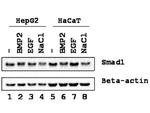Search Thermo Fisher Scientific
FIGURE: 1 / 1
Phospho-SMAD1 (Ser206) Antibody (600-401-B29) in WB

Product Details
600-401-B29
Species Reactivity
Host/Isotype
Class
Type
Immunogen
Conjugate
Form
Concentration
Purification
Storage buffer
Contains
Storage conditions
Shipping conditions
Product Specific Information
Store vial at -20° C prior to opening. Aliquot contents and freeze at -20° C or below for extended storage. Avoid cycles of freezing and thawing. Centrifuge product if not completely clear after standing at room temperature. This product is stable for several weeks at 4° C as an undiluted liquid. Dilute only prior to immediate use.
This affinity-purified antibody is directed against the phosphorylated form of human SMAD1 protein at the pS206 residue. Reactivity occurs against human SMAD1 pS206 protein and the antibody is specific for the phosphorylated form of the protein. Reactivity with non-phosphorylated human SMAD1 is minimal by ELISA and western blot. A BLAST analysis was used to suggest 100% cross reactivity with SMAD1 from human, Duckbill platypus, Drosophila, mouse, opossum, chimpanzee, bonobo, orangutan, gorilla, macaque, cattle, sheep, pig, rat, horse, salmon, chicken, and dog based on the sequence homology with the immunogen. Reactivity against homologues from other sources is not known.
Target Information
The protein encoded by this gene belongs to the SMAD, a family of proteins similar to the gene products of the Drosophila gene 'mothers against decapentaplegic' (Mad) and the C. elegans gene Sma. SMAD proteins are signal transducers and transcriptional modulators that mediate multiple signaling pathways. This protein mediates the signals of the bone morphogenetic proteins (BMPs), which are involved in a range of biological activities including cell growth, apoptosis, morphogenesis, development and immune responses. In response to BMP ligands, this protein can be phosphorylated and activated by the BMP receptor kinase. The phosphorylated form of this protein forms a complex with SMAD4, which is important for its function in the transcription regulation. This protein is a target for SMAD-specific E3 ubiquitin ligases, such as SMURF1 and SMURF2, and undergoes ubiquitination and proteasome-mediated degradation. Alternatively spliced transcript variants encoding the same protein have been observed.
For Research Use Only. Not for use in diagnostic procedures. Not for resale without express authorization.
References (0)
Bioinformatics
Protein Aliases: BSP-1; Dwarfin-A; Dwf-A; DWFC; hSMAD1; JV4-1; MAD (mothers against decapentaplegic, Drosophila) homolog 1; MAD homolog 1; MAD homolog1 (mothers against decapentaplegic, Drosophila); MAD, mothers against decapentaplegic homolog 1; Mad-related protein 1; MADH5; mMad1; Mothers against decapentaplegic homolog 1; mothers against DPP homolog 1; Mothers-against-DPP-related 1; Mothers-against-DPP-related-1; OTTHUMP00000220456; SMAD; SMAD 1; SMAD family member 1; SMAD, mothers against DPP homolog 1; SMAD5; TGF-beta signaling protein 1; transforming growth factor-beta signaling protein 1; Transforming growth factor-beta-signaling protein 1
Gene Aliases: AI528653; BSP-1; BSP1; JV4-1; JV41; Mad1; MADH1; MADR1; Mlp1; MusMLP; SMAD1
UniProt ID: (Human) Q15797, (Mouse) P70340, (Rat) P97588
Entrez Gene ID: (Human) 4086, (Dog) 475456, (Mouse) 17125, (Rat) 25671

Performance Guarantee
If an Invitrogen™ antibody doesn't perform as described on our website or datasheet,we'll replace the product at no cost to you, or provide you with a credit for a future purchase.*
Learn more
We're here to help
Get expert recommendations for common problems or connect directly with an on staff expert for technical assistance related to applications, equipment and general product use.
Contact tech support
